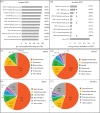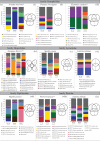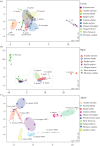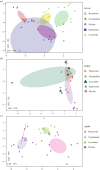Dietary and developmental shifts in butterfly-associated bacterial communities
- PMID: 29892359
- PMCID: PMC5990769
- DOI: 10.1098/rsos.171559
Dietary and developmental shifts in butterfly-associated bacterial communities
Abstract
Bacterial communities associated with insects can substantially influence host ecology, evolution and behaviour. Host diet is a key factor that shapes bacterial communities, but the impact of dietary transitions across insect development is poorly understood. We analysed bacterial communities of 12 butterfly species across different developmental stages, using amplicon sequencing of the 16S rRNA gene. Butterfly larvae typically consume leaves of a single host plant, whereas adults are more generalist nectar feeders. Thus, we expected bacterial communities to vary substantially across butterfly development. Surprisingly, only few species showed significant dietary and developmental transitions in bacterial communities, suggesting weak impacts of dietary transitions across butterfly development. On the other hand, bacterial communities were strongly influenced by butterfly species and family identity, potentially due to dietary and physiological variation across the host phylogeny. Larvae of most butterfly species largely mirrored bacterial community composition of their diets, suggesting passive acquisition rather than active selection. Overall, our results suggest that although butterflies harbour distinct microbiomes across taxonomic groups and dietary guilds, the dramatic dietary shifts that occur during development do not impose strong selection to maintain distinct bacterial communities across all butterfly hosts.
Keywords: diet; insect; metamorphosis; microbiome.
Conflict of interest statement
We declare no competing interests.
Figures







Similar articles
-
Heliconius Butterflies Host Characteristic and Phylogenetically Structured Adult-Stage Microbiomes.Appl Environ Microbiol. 2020 Nov 24;86(24):e02007-20. doi: 10.1128/AEM.02007-20. Print 2020 Nov 24. Appl Environ Microbiol. 2020. PMID: 33008816 Free PMC article.
-
Disrupting butterfly caterpillar microbiomes does not impact their survival and development.Proc Biol Sci. 2019 Dec 18;286(1917):20192438. doi: 10.1098/rspb.2019.2438. Epub 2019 Dec 18. Proc Biol Sci. 2019. PMID: 31847770 Free PMC article.
-
Metamorphosis of a butterfly-associated bacterial community.PLoS One. 2014 Jan 23;9(1):e86995. doi: 10.1371/journal.pone.0086995. eCollection 2014. PLoS One. 2014. PMID: 24466308 Free PMC article.
-
Phenological synchrony between a butterfly and its host plants: Experimental test of effects of spring temperature.J Anim Ecol. 2018 Jan;87(1):150-161. doi: 10.1111/1365-2656.12770. Epub 2017 Nov 29. J Anim Ecol. 2018. PMID: 29048758
-
Phylosymbiosis across Deeply Diverging Lineages of Omnivorous Cockroaches (Order Blattodea).Appl Environ Microbiol. 2020 Mar 18;86(7):e02513-19. doi: 10.1128/AEM.02513-19. Print 2020 Mar 18. Appl Environ Microbiol. 2020. PMID: 31953337 Free PMC article.
Cited by
-
Gut Bacteria in the Holometabola: A Review of Obligate and Facultative Symbionts.J Insect Sci. 2020 Jul 1;20(4):22. doi: 10.1093/jisesa/ieaa084. J Insect Sci. 2020. PMID: 32809024 Free PMC article. Review.
-
Parasitism by endoparasitoid wasps alters the internal but not the external microbiome in host caterpillars.Anim Microbiome. 2021 Oct 15;3(1):73. doi: 10.1186/s42523-021-00135-y. Anim Microbiome. 2021. PMID: 34654483 Free PMC article.
-
The red flour beetle Tribolium castaneum: A model for host-microbiome interactions.PLoS One. 2020 Oct 2;15(10):e0239051. doi: 10.1371/journal.pone.0239051. eCollection 2020. PLoS One. 2020. PMID: 33006995 Free PMC article.
-
Microbiome analysis of monarch butterflies reveals effects of development and diet.FEMS Microbiol Ecol. 2024 Nov 23;100(12):fiae143. doi: 10.1093/femsec/fiae143. FEMS Microbiol Ecol. 2024. PMID: 39557647 Free PMC article.
-
Construction of TUATinsecta database that integrated plant and insect database for screening phytophagous insect metabolic products with medicinal potential.Sci Rep. 2020 Oct 15;10(1):17509. doi: 10.1038/s41598-020-74590-z. Sci Rep. 2020. PMID: 33060804 Free PMC article.
References
-
- McFall-Ngai MJ. 2002. Unseen forces: the influence of bacteria on animal development. Dev. Biol. 242, 1–14. (doi:10.1006/dbio.2001.0522) - DOI - PubMed
-
- Fraune S, Bosch TCG. 2010. Why bacteria matter in animal development and evolution. Bioessays 32, 571–580. (doi:10.1002/bies.200900192) - DOI - PubMed
-
- McFall-Ngai M, et al. 2013. Animals in a bacterial world, a new imperative for the life sciences. Proc. Natl Acad. Sci. USA 110, 3229–3236. (doi:10.1073/pnas.1218525110) - DOI - PMC - PubMed
-
- Bright M, Bulgheresi S. 2010. A complex journey: transmission of microbial symbionts. Nat. Rev. Micro. 8, 218–230. (doi:10.1038/nrmicro2262) - DOI - PMC - PubMed
-
- Dillon RJ, Dillon VM. 2004. The gut bacteria of insects: nonpathogenic interactions. Annu. Rev. Entomol. 49, 71–92. (doi:10.1146/annurev.ento.49.061802.123416) - DOI - PubMed
Associated data
LinkOut - more resources
Full Text Sources
Other Literature Sources

